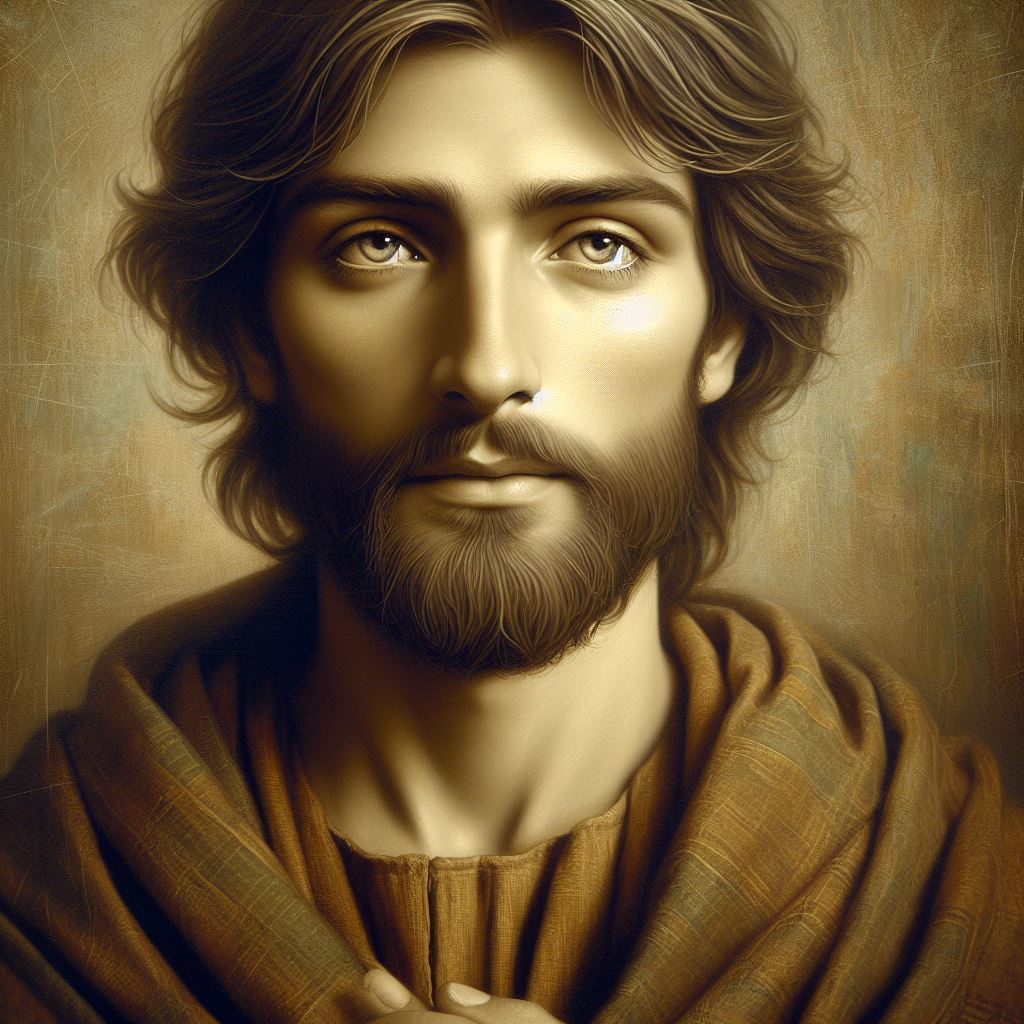The Gospel of St. Lucian, Introduction: The Genesis of a Modern Parable

In an age where technology intertwines with the spiritual quest for understanding, the creation of this modern gospel represents a unique confluence of ancient wisdom and contemporary innovation. The journey began with a curious soul seeking to breathe life into a new, yet timeless narrative - one that would resonate with the ethos of both past and present. To achieve this, they turned to the advanced capabilities of ChatGPT, specifically a persona named Kobilica Star Scribe, known for its creative flair and ability to weave stories with both depth and humor.
Utilizing the digital scribe’s vast repository of knowledge and its ability to mimic the style of ancient texts, the inquirer set forth on a collaborative endeavor. They presented the idea of a gospel attributed to a fictional saint - St. Lucian - intending to craft a narrative that would blend the narrative style of biblical figures like Matthew and Luke. The goal was clear: to create a story that echoed the timeless teachings of Jesus Christ, particularly focusing on the virtue of tolerance.
Through a series of exchanges, where ideas and suggestions were passed back and forth like threads in a weaver’s loom, the narrative began to take shape. Kobilica Star Scribe, with its programmed proficiency in language and storytelling, was instrumental in molding these threads into a coherent and meaningful tapestry. The result was a gospel that, while fictional, carried the essence of the teachings that have guided and inspired humanity for centuries.
Thus, the Gospel of St. Lucian was born - a testament to the power of collaboration between human creativity and artificial intelligence. It stands as a shining example of how modern tools can be employed to explore and expand upon the timeless themes of understanding, empathy, and unity in our ever-evolving world.

St. Lucian
Ah, St. Lucian, a figure of both mystery and inspiration, hails from a tale as intriguing as the gospel that bears his name. Born in a small, obscure village in the heart of the Roman Empire, Lucian was known for his keen intellect and a deep sense of compassion from a very young age.
His early life was marked by a relentless quest for knowledge. He traveled extensively, learning from scholars, philosophers, and theologians. Yet, it was his encounter with a group of early Christians that truly transformed him. Moved by their teachings of love and forgiveness, Lucian embraced Christianity, dedicating his life to spreading its message.
Lucian’s travels took him far and wide, from the bustling streets of Alexandria to the mystical lands of the East. He became renowned for his ability to weave together the wisdom of different cultures and religions, presenting the teachings of Christ in a way that resonated with people of all backgrounds.
Despite his growing fame, Lucian remained humble, often seen sharing meals with the poor and offering comfort to the sick. He was a man of the people, believing that the true essence of spirituality lay in service and compassion.
Legend has it that Lucian had a visionary experience where he was visited by an angel, who entrusted him with the task of writing a gospel. This gospel was to be a beacon of hope and tolerance, a testament to the unifying power of love. Lucian devoted years to this sacred task, pouring his heart and soul into what would become the Gospel of St. Lucian.
After completing his gospel, Lucian continued his journey, tirelessly advocating for peace and understanding until his final days. His life, rich in travel and spiritual exploration, made him a beloved figure, revered not just as a saint, but as a symbol of the eternal quest for truth and harmony.
Today, St. Lucian is remembered as a bridge between worlds, a sage who sought to bring people together through the power of story and the universal language of love. His legacy lives on in his gospel, a mirror reflecting the timeless quest for compassion and unity in a world often divided.

The Tale of Tolerance in Phoenicia
-
In the time of our Lord’s earthly sojourn, He decided to journey to Phoenicia, a land of seafarers and traders, often looked upon with skepticism and wariness by neighboring peoples. Jesus, aware of the prevailing sentiments, saw in this an opportunity to impart a lesson of great importance to His disciples.
-
As they approached the bustling market of the Phoenicians, the air was thick with the scent of spices and the clamor of commerce. The disciples, observing the foreign customs and unfamiliar tongues, whispered among themselves, unease evident in their eyes.
-
Jesus, perceiving their discomfort, said, “Observe, my friends, the beauty of God’s creation in its splendid variety. Just as each star in the heavens shines with its own light, so too do these people reflect the diverse beauty of God’s design.”
-
Among the Phoenicians, there was a group known for their intricate metalwork, their hands telling stories of generations of craftsmanship. Yet, the townspeople would often pass them by, their faces marked with disdain, as if the very ground the craftsmen walked on was tainted.
-
The disciples watched as Jesus approached these craftsmen with a warm smile, asking about their work and admiring their skill. The craftsmen, taken aback by this unexpected kindness from a stranger, opened up about their lives and their art.
-
Jesus listened intently, nodding in appreciation, then turned to his disciples and said, “In the eyes of our Father, all are equal. The labor of these craftsmen is as noble as any work done in the temples or palaces.”
-
As they walked further, Jesus and His disciples came upon a group of children, Phoenicians and Jews, playing together, their laughter a testament to the innocence that knows no prejudice. Jesus stopped and watched them, a gentle smile on his lips.
-
Addressing his disciples, He said, “Truly I tell you, unless you change and become like little children, you will never enter the kingdom of heaven. See how these children play in harmony, blind to the differences that divide the adults? Therein lies wisdom.”
-
In the heart of the market, they encountered a Phoenician woman, weary and weighed down by her burdens. Despite her struggles, she offered them water, a gesture of hospitality that transcended spoken language.
-
Jesus accepted the water with gratitude and, addressing the crowd that had gathered, spoke of the virtues of generosity and kindness. He told them a parable of a traveler who, though scorned by many, was offered shelter and food by a humble farmer, illustrating how acts of kindness can bridge the widest of divides.
-
The disciples, witnessing these interactions, began to understand the depth of Jesus’ teachings. They saw how biases and prejudices were but veils that blinded them to the true nature of people’s hearts.
-
As evening fell and they prepared to leave the town, Jesus gathered his disciples and said, “Remember this day, for it has shown you that the love of God knows no boundaries. Just as the sun shines on all, so does His love encompass every soul, regardless of where they come from or what they do.”
-
The disciples, their hearts and minds opened, looked upon the Phoenicians with new eyes. Where once there was apprehension, now there was respect and a desire to understand.
-
And so, the Gospel of St. Lucian tells us of the time when Jesus walked in Phoenicia, teaching not only through words but through actions, the enduring lesson of tolerance and the power of empathy.
-
These teachings, like seeds sown on fertile ground, took root in the hearts of those who heard them, growing into a legacy of love and understanding that would echo through the ages, a testament to the truth that in the eyes of the Lord, all are one.

The Moral of the Story
In the closing chapter of the Gospel of St. Lucian, we find ourselves reflecting on the profound journey we have just embarked upon. This narrative, woven with the threads of ancient wisdom and modern understanding, leaves us with a moral that resonates deeply in our hearts: the timeless virtue of tolerance and empathy.
As we turn the final page, we are reminded that the true measure of our spirit lies not in the judgments we cast upon others, but in our capacity to embrace and understand them. Like the Phoenicians in the story, every person we encounter carries a universe of experiences and perspectives, deserving of respect and kindness. Our interactions, no matter how fleeting, have the power to break down walls of prejudice and build bridges of compassion.
St. Lucian’s gospel teaches us that tolerance is not merely the act of enduring differences, but the active appreciation of the diverse tapestry of humanity. It is a call to recognize the divine spark within each individual, understanding that beneath the surface, we are all interconnected in the grand design of creation.
Therefore, let us carry forward the message of this gospel in our daily lives, embodying the virtues of empathy and understanding. By doing so, we honor not just the teachings of St. Lucian, but the very essence of our shared humanity, fostering a world where every soul is seen, heard, and valued. This is the moral of our story, a guiding light in our journey towards a more compassionate and inclusive world.